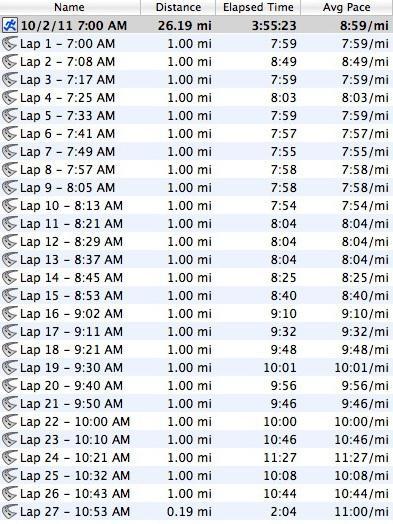A very great vision is needed, and the man who has it must follow it as the eagle seeks the deepest blue of the sky.
– Crazy Horse
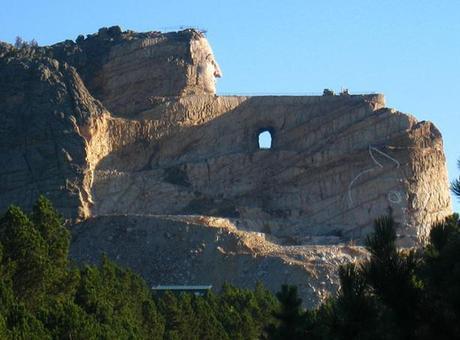
The devil, we’re told, is in the details. In which case some readers may deem me a practicing Satanist. In an effort to document the races I run for myself and like-minded runners, I prefer to err on the side of ample detail. Creating and writing this blog hasn’t necessarily changed how I observe and absorb the world around me, but it has given my brain a more compelling reason to do so. I now appreciate the importance not just of seeing but of noticing – noteworthy facts, amusing details, poignant behaviors. The stuff that makes every race – and even the most ho-hum training run – unique from every other.
BC&H was born after my near-literal meltdown on Mt. Diablo in April 2012. More recently, though, in considering the 44 races of varying distances (including four marathons) that I logged prior to Diablo, it struck me that I really should have begun the blog six months earlier. I should have begun with a race that still ranks among my favorite running experiences, and whose blow-by-blow details remain remarkably vivid in my mind two years later. I should have begun with the 2011 Run Crazy Horse Marathon.
And so, with the help of Garmin, Google Maps and Katie’s own memory and record-keeping, I’ve decided to put my pre-blog perspicacity to the test, and right this wrong before it gets any wronger. Besides, I’d hate to look back years from now, once I’ve hopefully medaled in all 50 states and on all 7 continents, and end up kicking myself because I’m left with only vague, surreal memories of an extraordinary weekend in the Black Hills of South Dakota.
Here then is the truth, the whole truth and nothing but the truth (as I remember it) about marathon #2 in state #2 – inspired by a single-minded sculptor who was every bit as crazy as the legend he sought to immortalize.
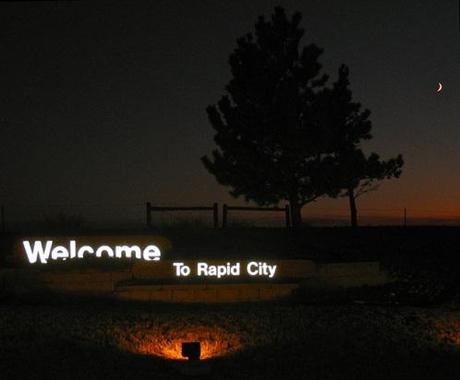
The Motive
I live in a scenic warm-weather state full of amazing races. Why, then, for my second marathon would I travel to the middle of the country to run in a state that most Americans think of (if they think of it at all) as Flyover Land? A state that too often gets grouped with its northern counterpart under the collective heading of “The Dakotas”?
I’d visited South Dakota nearly a decade earlier, with buddies Pete and Matt on a road trip through several of the less populated states. Realizing Katie would get a similar charge out of its natural beauty and majestic monuments, I resolved to bring her back with me on a future visit. Nine years later, while training for the 2011 California International Marathon, I remembered hearing of an October marathon in South Dakota that allowed runners to start from either of the state’s two deftly chiseled mountains, the Mount Rushmore National Memorial or the Crazy Horse Memorial. That was all I needed to know, to know I’d found my next race.
My interwebs research quickly revealed that the “Monument Challenge” Marathon had been discontinued two years earlier, in 2009. Fortunately, it had been reborn the following year as the inaugural Run Crazy Horse Marathon. More importantly, what hadn’t changed was that the two memorials still sat nestled in the Black Hills, only 16 miles apart.
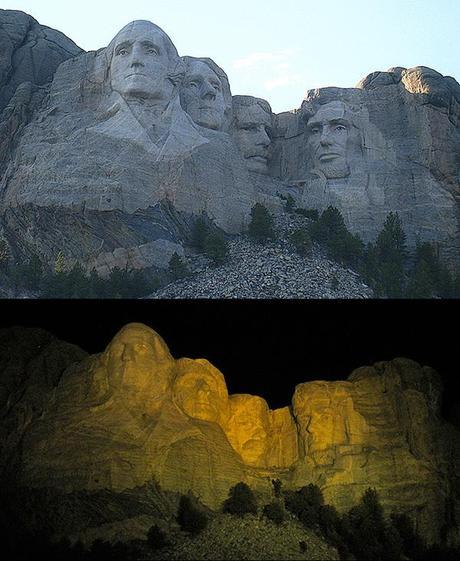
The difference between these two is like night and day
So it was that Katie and I found ourselves on Friday flying into South Dakota over the dark, tree-covered terrain that earned the region its Lakota designation – Paha Sapa, or “hills that are black”. Our flight touched down in Rapid City, which lies in the southwest corner of the state and is its second most populous city after Sioux Falls. Luckily for us, the timing of race weekend happened to coincide with the final evening lighting ceremony of the year at Mount Rushmore, which was scheduled to start 90 minutes after our plane landed. So we hit the ground renting (a car, that is) and made the 45-minute drive in time for Katie to witness Mount Rushmore as few visitors do their first time – with the faces of Washington, Jefferson, Roosevelt and Lincoln slowly emerging out of the Black Hills darkness and into (artificial) light.
Mount Rushmore is one of the few national icons that every American recognizes. In fact, its façade is so ubiquitous in American culture that you could be forgiven for assuming, as I did, that the real thing couldn’t possibly live up to the hype. But you’d be wrong. Seeing those four intricately carved faces gazing like silent sentries from atop the mountain is breathtaking even in broad daylight, against the typical backdrop of visitor traffic and vocal toddlers. But at night, under dramatic lighting and with life’s usual exhortations muted, the majesty of Mount Rushmore speaks softly and carries a very big stick.
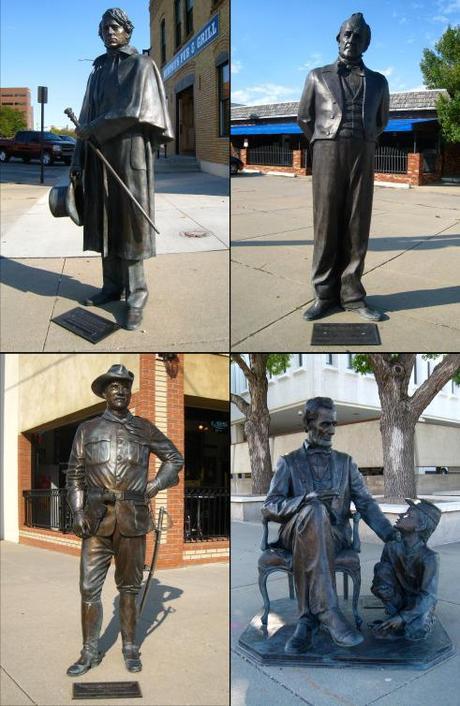
Rapid City’s “City of Presidents” includes (clockwise from upper left) Franklin Pierce,
James Buchanan, Abraham Lincoln and Theodore Roosevelt
(It’s unclear whether the real Buchanan had a rhino-like horn on his head)
After bidding Mount Rushmore goodbye, we headed back to Rapid City, where we enjoyed a late dinner at Wine Cellar, a local restaurant with the look and feel (if not quite the food) of a Napa Valley bistro. Our waiter welcomed us with the news that we’d arrived in the midst of an unseasonal heat wave (my 8th grade English teacher would call this foreshadowing). He also shared his story of how, the previous summer, Guns N’ Roses had dropped by the restaurant for dinner prior to playing the nearby Sturgis Monkey Rock USA Festival, their first U.S. show in four years – and how, in typical Axl Rose fashion, their time to hit the stage had come and gone while the band’s members sat in the restaurant. I had to smile at the comforting thought that – nearly 20 years after I’d twice experienced that same G N’ R volatility as a college kid in Houston – the more Axl changed, the more he stayed the same.
Saturday began with a short morning run along the Mickelson Trail near our hotel in Hill City (my 8th grade English teacher might point to the town’s name as a second example of foreshadowing). We then grabbed lunch on Main Street, site of the next day’s finish line. I would say Hill City looks like a land that time forgot, except I’m not sure the town cares to be remembered. With business names like the Bumpin Buffalo Bar & Grill, the Mangy Moose Saloon and Broken Arrow Trading Company, Hill City gives the impression of a dusty one- or two-horse town that embraces its Wild West ethos. Amidst the quaint local shops that line Main Street, the town’s Harley-Davidson dealership offers a nod to the pervasive and freewheeling biker (i.e. motorcycle) culture that puts this region on the national map for one week a year in August.
After lunch we made the quarter-mile walk across town to the Boys & Girls Clubs of the Black Hills, where the low-key race expo was housed in one modestly sized room. We quickly negotiated the 5-10 sponsor booths, with the exception of one booth where a chatty older woman selling alkalinized water bent our ear for several minutes, seemingly delighted to have someone to talk to.

The elevation profile agrees: the high point of the course was the monument at mile 2
Katie studied the posted list of registered runners and commented on how few out-of-towners would be running the marathon. Meanwhile, glancing at the course map, I was taken aback to discover a key variable I’d completely overlooked in my twitterpated zeal to revisit the Black Hills: elevation. Turns out the marathon would begin at 5,919 ft of elevation before reaching its zenith at 6,083 ft (foreshadowing hat trick complete). But at just over a mile high, I tried to reassure myself, how much of an impact could altitude really have? After all, I’d gained 7,815 vertical feet to finish the Pikes Peak Ascent at 14,115ft the previous summer – a ludicrous comparison that did absolutely nothing for my confidence.
With race bib and newfound trepidation in hand, we made the 30-minute drive back to Rapid City, where we strolled its impressive downtown “City of Presidents” display of life-size bronze statues honoring all 43 former U.S. Presidents (with Barack Obama in the works). Collectively, the statues elevate Rapid City from “sleepy town near Mount Rushmore” to “sleepy town with cool historical diversion near Mount Rushmore”.
Feeling like participants in a South Dakota scavenger hunt, we hopped back in the car and returned to Mount Rushmore, where we were able to appreciate the monument in full daylight and from all possible ground angles, via a walking path that leads around the base of the mountain. At last, the time came to bid Rushmore adieu for the second and final time – Crazy Horse beckoned, and who were we to keep a legend waiting?
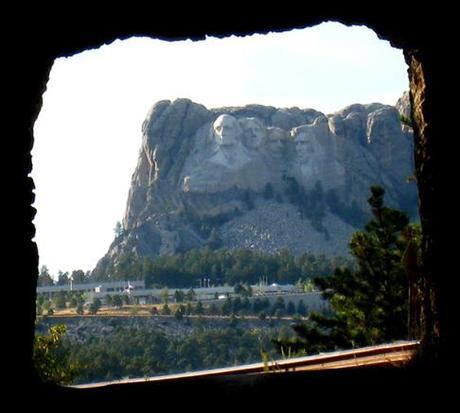
Mount Rushmore as framed through a one-lane tunnel on U.S. Route 16A
The Monument
The sprawling horizon was reeling in a rose-hued sun as we pulled into the parking lot of the Crazy Horse Memorial. Despite being the final listing under the heading of “National Parks and Monuments” on South Dakota’s Wiki page, Crazy Horse is an astonishing testament to one man’s vision, tireless resolve and get-‘er-done-itude. Except that sadly, it isn’t done… and in fact it’s nowhere close.
The Memorial began life as the passion project of Korczak Ziolkowski, a Boston-born sculptor of Polish descent. After assisting fellow sculptor Gutzon Borglum in the creation of Mount Rushmore, Korczak returned to the Black Hills in 1947 at age 38 at the invitation of Lakota Chief Henry Standing Bear, who shared his idea for a similar mountain tribute to honor Native Americans. “My fellow chiefs and I would like the white man to know the red man has great heroes, too,” wrote Standing Bear. Work began and the Crazy Horse Memorial was dedicated on June 3, 1948.
The sheer size and scope of Korczak’s project is mind-boggling. The sculptor designed his carving of Lakota war leader Crazy Horse, pointing with outstretched arm astride his steed, to be the largest sculpture in the world: upon completion, it would measure 563ft high by 641ft long. All four heads of Mount Rushmore would easily fit inside Crazy Horse’s own 87½-foot-high head.
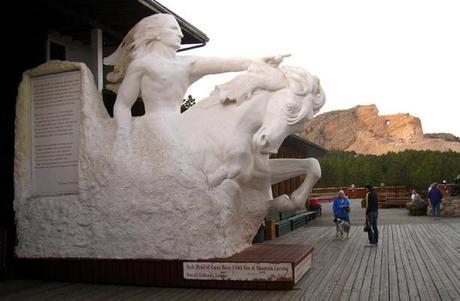
Sculptor Korczak’s 1/34-size scale model of the finished monument (with the real thing in the background)
Unfortunately, due to Korczak’s insistence that the project subsist entirely on charitable donations and private funding, work on the monument has proceeded at a lugubrious pace, and only the Lakota Chief’s face has so far been completed. According to the Crazy Horse Memorial Foundation, Korczak twice refused federal grants of ten million dollars because he wanted his Memorial to be a “humanitarian project built by the interested public and not the taxpayer.”
Korczak’s master plan extends beyond the monument itself, envisioning an entire campus that includes an Indian Museum of North America and the American Indian University and Medical Training Center. After his death in 1982, Korczak’s wife Ruth along with seven of their ten children took up the mantle and continue to oversee work on the project to this day. If and when the Memorial might be completed, however, remains anyone’s guess.
So I was happy to support Korczak’s grand vision, and my support began with a pre-race pasta dinner at the Memorial’s Laughing Water Restaurant, followed by a laser light show projected on the monument itself. Whereas the meal was excellent in its simplicity, the light show was well-meaning but surreal, thanks in part to its ’70s musical choreography. In particular, “Music Box Dancer” is a discomforting instrumental that would – as bad music is wont to do – spend the rest of the weekend pirouetting its way through my impressionable brain. Ouch.
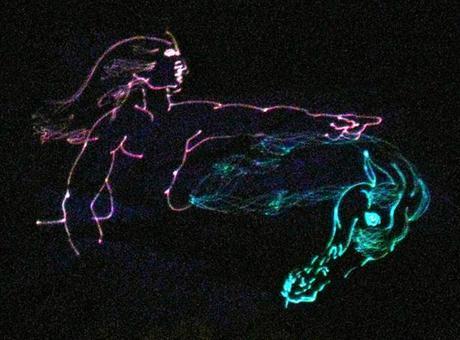
The laser light show was projected on the monument itself
The Marathon
On Sunday morning we made the return drive from Hill City to Crazy Horse for the 8:00a.m. marathon start. With the awakening sun stretching out over the Black Hills and the start area still swathed in shade, the already warm weather brought to mind our waiter’s words from two nights earlier: unseasonal heat wave. I was wearing the most lightweight tech shirt I owned, carrying a bottle of my usual Cytomax/GU concoction, and hoping most of the course would be adequately shaded. I might just as well have hoped for Pegasus to swoop down and carry me across the finish line.
I have vague recollections of Native American drum beats playing to start the race and send 700 eager runners on our way toward Hill City. Beginning from the Memorial Visitors Center, the first 3.5 miles of the course would be run on Memorial grounds. After initially leading runners away from the monument, the course looped back past the “BLASTING AREA CLOSED TO PUBLIC” sign and to a turnaround point just below the mountain. Glancing upward yielded an awesome view of Crazy Horse’s meticulously chiseled face. Then the monument was behind us once again, and the paved course headed downhill and out of the complex to meet up with the region’s famed George S. Mickelson Trail.

If the mountain won’t run to Muhammad…
The next ten miles, cruising along the crushed limestone and gravel surface of the Mickelson Trail adjacent to U.S. Route 16, infused me with a Bob Marley-like confidence that Every little thing, gonna be all right! Verdant pines and golden autumn foliage threw wispy shadows across the sun-dappled trail, which periodically traversed a converted railroad bridge. Adding to my confidence was the trail’s persistent downward trajectory, which enabled me to pass several runners and string together ten relatively easy 8-minute miles. I resolved to bank time by running comfortably fast on this first-half descent, though not so fast that I risked flaming out before the more demanding second half.
As we approached the midway point of the race, the course transitioned from the comfy packed gravel of the Mickelson Trail onto the asphalt Main Street of downtown Hill City. Here, across from the Bumpin Buffalo, the inflatable black-and-blue (coincidence?) finisher’s arch greeted joyful half marathoners while spurning the rest of us. This struck me as the ultimate mind game, forcing the 26.2ers to pass within inches of the finish line while watching our fellow 13.1ers collect their medal and revel in their accomplishment. The race organizers clearly have a sadistic streak, and even at the time I had to nod my approval.
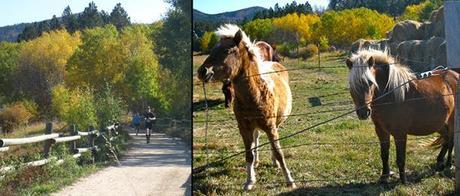
Nearing mile 19 on the Mickelson Trail (left), where shetland ponies look on in bemusement (right)
If the first half of the race was the charming Dr. Jekyll, the second half morphed gruesomely into Mr. Hyde. A hilly 13-mile out-and-back awaited, and the sun’s onslaught intensified as if seizing its opportunity to do some damage along this shade-free stretch. Katie was waiting as always with a smile and encouragement as the course left Main Street, circled Major Lake and began its punishing ascent toward a reunion with the Mickelson Trail.
Returning to the smooth dirt surface of the Mickelson Trail, my pace gradually slowed. I was already fighting the twin trials of escalating 80-degree heat and mile-high elevation, and strike three would come in the form of a steady uphill out to the turnaround point at mile 19.6. The blunt-force reality of the situation hit me along that out-and-back stretch, when I looked up to see the leader and eventual winner – who was headed back in the opposite direction – stopped in his tracks and standing bent over with hands on knees. That’s not something you want to see at any point in a race, much less before you’ve even reached the turnaround.
Katie had driven to the aid station where Deerfield Rd intersected with the Mickelson Trail, and was waiting to cheer me on just after mile 18. We traded a few words as I walked through the aid station in an attempt to cool down and rehydrate. Unfortunately the aid station doubled as a transfer point for the marathon relay – and as annoyances go, there’s little to rival the bouncy, fresh-faced relay runner who starts their race at mile 20 and clearly expects your dragging ass to yield the right-of-way to them as they fly by.
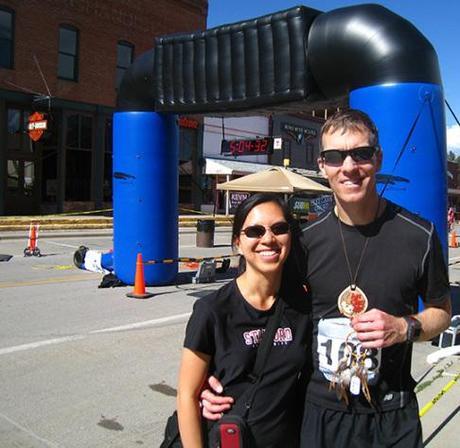
Katie would be front and center on the Mount Rushmore of support crews
By the time I returned to that same aid station 3½ miles later, I was feeling light-headed from the combination of elevation and sun exposure, and also embarrassed that Katie was still there to see me slowly shuffle by like an overheated mule. Four painfully long miles lay ahead, and as Katie cheered me on with promises to meet at the finish, I reflected bitterly on the FAQ section of the race website:
Will I be affected by the altitude, especially if I am flying from a place at or near sea level?
The short answer is “no,” you won’t be affected. The slightly longer answer is that any minimal affect from the altitude is offset by the perfect running conditions, cool and dry.
All I want, I told myself more than once, is to finish this race… Crazy Horse ain’t got nothin’ on this insanity. Suddenly, the Bumpin Buffalo and Mangy Moose felt very far away. And I couldn’t imagine how the few runners I’d passed must be feeling. I walked my oxygen-deprived muscles through yet another aid station, dousing myself with water in a futile attempt to revive myself. By this time my pace had crept up into consistent 10-minute/mile territory (mile 24 even crawled above 11 minutes), and I entered the runner-populated town of Bonk City – a city devoid of homes, offices or even roads, but with only one impassably high Wall encircling the entire city. And struggle as I might, there was no way I’d be scaling The Wall in my overheated state.
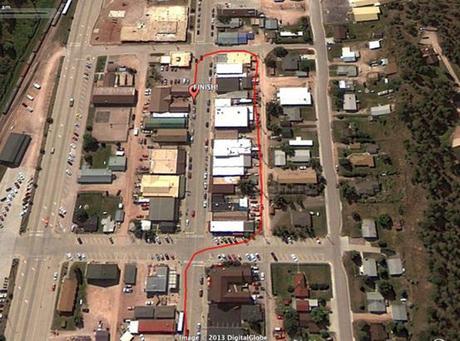
The shortest distance between two points is NOT this convoluted path to the finish (Google Earth)
I had heat-induced visions of the race organizers surreptitiously extending what now seemed a never-ending stretch of trail. Damn thing has to end eventually. And at long long last it did, transitioning back on to now-blessed asphalt. Wearily I took a few deep breaths as I shuffled my way down that final incline, not daring to look at my Garmin for fear I’d already blown past the four-hour mark. I reached Main Street and approached the finisher’s arch from the opposite direction. And whether I was thinking of myself or the finish line, the only two words my sun-addled brain could register were dead ahead. This time the finish line couldn’t turn me away…
Except it did. Roughly 50 yards from the finish, we were unexpectedly detoured by a right turn, followed by a quick left that led us down one last 0.1-mile stretch of alleyway parallel to Main Street. And I’d thought the race organizers were sadistic at mile 13.1. With that final blow to my psyche, I honestly felt I might collapse in that alleyway, propped up against a fence and unable to stand after running 26.1 miles. I felt none of the home-stretch euphoria that’s typified every other marathon I’ve run – only a grinding, full-body exhaustion. But stay upright I did, long enough to make two more quick left turns that led me back to Main Street and across the finish line in a surprisingly triumphant time of 3:55:22. Turns out my strong first half had more than covered for my shaky second half.
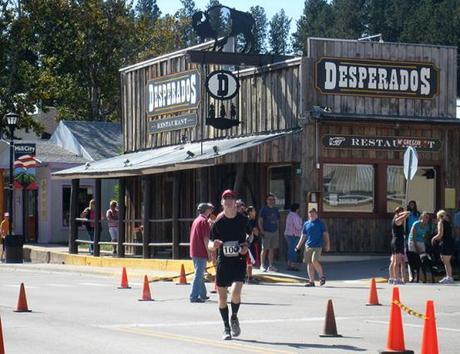
Desperado may be Lakota for “desperate to finish this race before it kills me”
The Aftermath
Crossing that finish line might have elicited more emotion if my equilibrium hadn’t been in such turmoil. Gratefully I accepted my ceramic finisher’s medal from a smiling volunteer and, after eschewing (because there’d be no chewing) solid food in favor of a few sips of Powerade, I sprawled out awkwardly on my back on a knee-high brick wall. The rough brick was only slightly more forgiving than lying on stairs, but at that moment I needed to lie down somewhere I wouldn’t be underfoot.
Fortunately I was able to avoid making any gastric sacrifices to the running gods, but suffice it to say I’ll always have naus-talgic memories of Crazy Horse.
As I lay there trying to regain some sense of normalcy, Katie checked the results and discovered that my sub-four finish had earned me third place in my age group. For my effort I received a very cool dreamcatcher, which remains the most distinctive award (age group or otherwise) I’ve received to date.
Although my pose – flat on my back with sunglasses shielding my eyes – couldn’t have looked too inviting, another fellow stopped alongside me to ask “Hey how do you like those compression socks do you wear them for all your marathons I tried to wear mine for a 50K a while back but they really messed up my Achilles so now I can’t wear them anymore but I was just wondering how you like ‘em I mean do they give you any problems ‘cuz like I said mine rub my Achilles and…” Still queasy and getting queasier by the word, I croaked out a weak “They’ve been great.” This seemed to either satisfy his curiosity or clue him into my plight, because he continued on his way without another word.
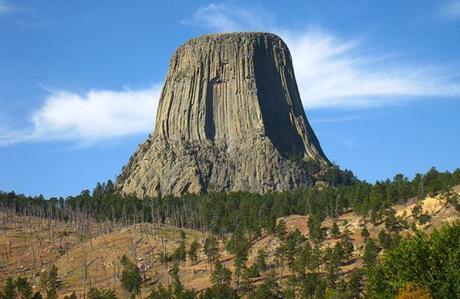
Devils Tower was our first national monument (1906), and still is one of many good reasons to visit Wyoming
Eventually I stumbled to my feet and we returned to our nearby hotel, where I collapsed on the bed for another few minutes before dragging myself into the shower. After checking out we settled on Subway as a safe and familiar lunch option to appease my disgruntled GI tract. Then it was time to put South Dakota in our rearview mirror, and we were able to admire the not-quite-autumnal textures of the Black Hills one last time as we crossed the border on Interstate 90 into rugged Wyoming. That evening and the next morning we hiked around Devils Tower, the nation’s first national monument and another awe-inspiring testament to the power and beauty of Flyover Land.
The American philospher George Santayana warned us that “Those who cannot remember the past are condemned to repeat it.” Hopefully one day, in the case of one memorable weekend in the Black Hills, those who can remember it will have that same chance.
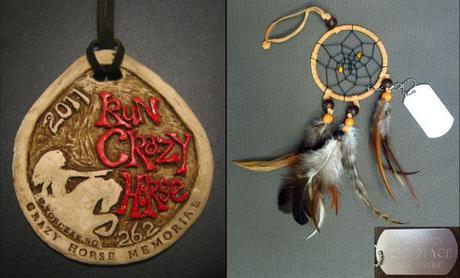
BOTTOM LINE: The race’s official name says it all – Run Crazy Horse. The Marathon offers a wicked combination of picturesque beauty, historical context and a challenging course you’ll both love and hate in a span of five miles. As such, Crazy Horse is a no-brainer for any runner looking to get out, explore a less ballyhooed region of the country and spice up their race catalog. I appreciate the argument against desecrating nature, but at the same time if you’re going to vandalize a mountain, you’d better have a Mount Rushmore or Crazy Horse to show for it.
PRODUCTION: Sadistic though they may be, the organizers of the Run Crazy Horse weekend did a terrific job from start (expo and pre-race dinner) to finish (medals). The Marathon had the comforting feel of a low-key trail race, yet without any wrong turns or logistical glitches. Though I carried my own bottle and the details of the aid stations escape me, I recall them being there when I needed water to dump on my head. As swag goes, the race shirt was a serviceable red short-sleeve tech tee. But the stars of the show, other than the Memorial itself, were the ceramic finisher’s medal and age-group dreamcatcher, both of which will always evoke the spirit of Crazy Horse and the dedication of those who have toiled to keep his memory alive.
For another perspective, I’d recommend Dan’s eerily similar experience at the 2012 Run Crazy Horse Marathon.
FINAL STATS:
October 2, 2011
26.19 miles from the Crazy Horse Memorial to Hill City, SD (State 2 of 50)
Finish time & pace: 3:55:22 (first time running the Run Crazy Horse Marathon), 8:59/mile
Finish place: 21/119 overall, 3/9 in M(40-44) age group
Race weather: Sunny and unseasonally hot (temperatures reached the low 80s)
Elevation: 5,919ft at the start, 6083ft max
